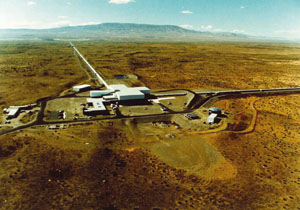The latest generation of high-precision experiments is bringing observers one step closer to detecting the elusive song of gravity waves.

Two of the world’s interferometric gravitational wave detectors – Japan’s TAMA project and the LIGO laboratory in the US – have recently attained two significant milestones in the ongoing quest to detect the waves produced by gravity in transit.
The 300 m TAMA interferometer near Tokyo, which achieved extended servo lock in 1999 (see The quest for gravitational waves), has continued to pioneer the field. Last September, in a thrilling two-week test run, TAMA logged 160 h of interferometer “in-lock” operation, proving the viability of the technique as well as its reliability.
Not only did the TAMA team by far surpass its target of 100 h in-lock, but it was able to maintain individual lock periods lasting as long as 12 h, in spite of the dauntingly noisy local seismic environment.
During the in-lock time of an interferometer – equivalent to the storage time of a particle collider – the instrument listens intently for the whispers of the universe. Longer in-lock time means more efficient listening capabilities.
Greater sensitivity
Even more important is the fact that in less than two years, the TAMA group has lowered the noise floor by more than two orders of magnitude, to an astonishing 10-21 strain sensitivity. In a small frequency range, this is close to the design value.
The strain sensitivity of an interferometric gravitational wave detector is analogous to the luminosity (collision rate) of a particle collider. The greater the sensitivity, the greater the range of the interferometer, and the shorter the time it must wait to register any signal of a stellar collision or an explosive event.
LIGO laser beams

Meanwhile, in the desert near Hanford, Washington State, the LIGO group has been chasing laser beams down the twin 2 km beam tubes of the first, and smallest, of LIGO’s three gravitational wave interferometers.
Various partial configurations have been tested during recent months, including a recombined Michelson-Morley interferometer with Fabry-Perot arms. Lock periods of several hours were solidly achieved, although without the power recycling system that was planned for the final configuration.
Then, in a momentous week last October, both Fabry-Perot arms of the complete Michelson-Morley interferometer came alive, with the power recycling cavity fully operational.
The latter is so named because it gathers the return laser power from the interferometer and recycles it. When operating, this configuration stores up to 30 times as much power in the arms, thereby increasing the interferometer’s high-frequency sensitivity. One drawback is that the power recycling mirror makes the interferometer controls an order of magnitude more difficult.
As these breakthroughs were being made, the atmosphere at LIGO was tense but cautiously optimistic. The locks achieved were somewhat unstable – lasting a few minutes at the most – and the stored beam power was always very low. Nevertheless, it was reassuring to see that everything was working, even if only for a short length of time.
The importance of these locks for LIGO is comparable with the first flight of the Wright brothers, of which an observer said: “It doesn’t stay up long. It isn’t very far off the ground. But it does fly!”
A long and challenging road must still be travelled before gravitational wave physicists can hope to snare these elusive ripples. The TAMA group must improve the interferometer’s high-frequency sensitivity curve by enhancing laser stability and introducing their power recycling cavity, while also implementing a state-of-the-art seismic attenuation system on the low-frequency end.
With the start-up of the Hanford 2 km interferometer, LIGO’s commissioning team has only just begun the work that will be required to render it fully operational. The LIGO crew will have to follow the same troubleshooting and improvement route as their Japanese colleagues. A series of engineering runs will be used to collect data and pinpoint any sources of trouble.







